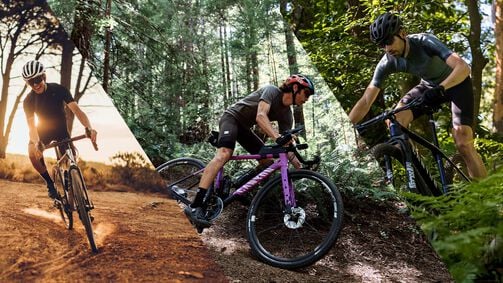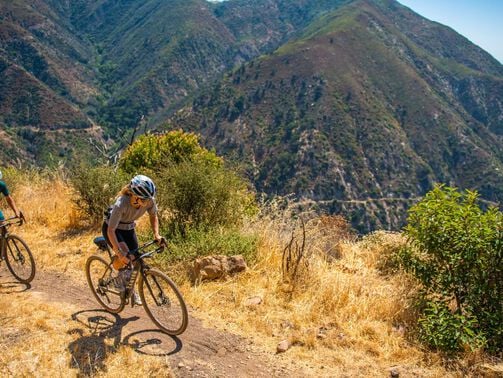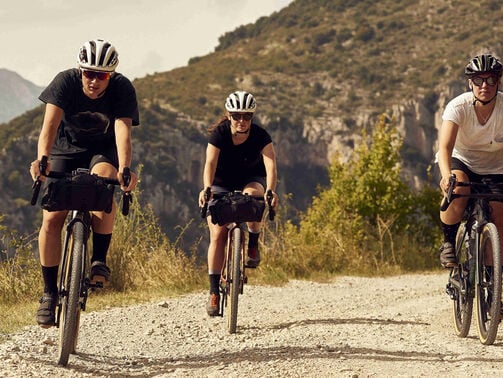How to choose the best gravel bike: Your ultimate buying guide
Deciding on a new gravel bike can be a rocky road. Let’s pedal through the pros and cons of each Canyon option together in this buyer’s guide.


The reasons to buy a gravel bike are as varied as the terrain you ride and deciding on which bike can be just as difficult as descending a steep and winding road. But it doesn’t have to be. This gravel bike buyer’s guide will help you figure out which gravel bike you should choose and why.
Contents
What is a gravel bike?
Imagine if a road and mountain bike had a baby; odds are, it’d look like a gravel bike. Boasting wide tires, long wheelbases, and a somewhat relaxed geometry, these rugged machines allow you to tackle tarmac, dirt, and gravel surfaces with ease. Gravel bikes are designed for versatility, providing plenty speed on the road while offering the durability and stability needed for off-road adventures. Whether you're riding through gravel paths or navigating rough trails, a gravel bike is built to handle it all without compromising comfort or speed.
Why choose a gravel bike?
For more than a decade, gravel riding has been one of the most popular segments of the bike industry. There’s something exciting about discovering a lonesome gravel road disappearing into a forest or up a mountain and thinking to yourself, “I’m going to follow it until it ends.”
You can more than likely find plenty of gravel races within a short drive or riding buddies looking to explore forest roads and a never-ending series of gravel backroads with you. A gravel bike may also be the most versatile bike you can own, able to tackle whatever terrain you can throw at it.
Understanding gravel bike types and ride styles
Gravel bikes generally offer comfort, versatility, and ruggedness, with Canyon boasting a few different options depending on the style of riding you enjoy and do most.
How to choose a performance gravel bike
The Grail is Canyon’s bike designed for gravel racing. The tire clearance isn’t as wide as its beefier siblings and cousins, but it’s lighter and designed to be faster, using aerodynamic tube shapes to cut through the wind on those wide-open gravel courses. It also handles more agilely for when you’re riding in a pack and trying to avoid road obstacles.
If you’re looking for a do-it-all bike, the Grail deserves consideration. Swap out the more rugged tires with some road slicks, and you can use the Grail as your everyday road bike, although it doesn’t quite offer the absolutely dialled feel on smooth surfaces that a dedicated road machines like the Endurace or Ultimate do.
While not technically a gravel bike, the Inflite is a fast and agile cyclocross machine that can also serve as a gravel racer if you participate in both activities.
How to choose a gravel bike for bikepacking
The Grizl is designed for bikepacking and adventure riding. It’s built like a tank, with multiple mounting points where you can attach bags holding your tent, sleeping bag, and other bikepacking gear. Although the Grizl performs admirably on pavement, where it really excels are gritty, rocky, or sandy trails.
You have tons of choices with the Grizl. Do you go with an aluminum frame, which is less expensive and can take a bit more of a beating, or the lighter and more comfortable carbon? Rigid or 30 mm suspension fork? Shimano or SRAM components? Luckily, whatever choice you make leads to adventure!
If you spend most of your time on singletrack, Canyon’s hardtail mountain bike the Exceed works well as a beefy bikepacking rig.
How to choose an electric gravel bike
If you want the extra power boost an e-bike promises, then the Grizl:ONfly should be at the top of your list. Its Bosch Performance Line motor will help you power up the steepest hills and makes hitting faster speeds much easier than relying on your legs alone. This is one of the lightest and off-road capable e-bikes that you’ll find on the market today. It even offers integrated lights and theft protection, as well as smart navigation and fitness capabilities via the Bosch ConnectModule and Flow App.
Canyon gravel bike models: pick the exact right one for you
Decided which gravel bike type is right for you?
Now it’s time to pick which exact model you need! Luckily, at Canyon we’ve got a logical naming system that makes it a bit easier.
If you’ve browsed through a couple of our bikes, you’ll have seen that a typical Canyon gravel bike name might read something like ‘Grail CF SLX 8 Di2’ or ‘Grizl 5’, to use two examples.
This is what it all means.
What does the number in the name of Canyon gravel bikes mean?
In short – the higher the number in the name, the more premium the components.
In general it’s important to remember: even on our most affordable gravel bikes, the standard of modern bike components is very high in terms of reliability and durability. That’s to say, even on a Grizl 5 you could ride across entire continents or around the entire globe (as long as you keep your gravel bike well maintained and looked after).
However, on the higher-number bikes, the higher-quality components are significantly lighter, and feel more premium and more comfortable, which makes a major difference the more time you spend in the saddle.
Example of upgrades you’ll see at higher levels include things like electronic gear shifting, carbon wheels, more premium tyres – all feel awesome and we can promise that upgrading to parts like these gives you a major boost in terms of speed and comfort. BUT: functionally, remember it’s nothing you absolutely need to take on epic rides and love them.
What do Canyon’s CFR/CF SLX/CF SL mean?
In most cases, this refers to the frame material – CFR bikes using the world’s best carbon, CF SLX using high-end advanced carbon, and CF SL using high-quality carbon fibre. Of course, we tend to fit a higher spec of component onto the higher-end models.
| Title | Description |
|---|---|
| CFR | The choice of the pros: If a bike has CFR in the name, you know it’s the best of the best we can build. Raced by our pros, constructed from the highest grades of carbon fibre, and built out with the finest parts available on the market today. |
| CF SLX | Engineered perfection: CF SLX means championship-level performance at price point geared towards high-end amateur athletes. Superlight carbon frames are fractionally heavier than their CFR cousins, and we combine them with high-end components from the world’s leading manufacturers. |
| CF SL | Carbon for all: CF SL bikes take all our design mastery and carbon fibre expertise and makes it in available in our most accessible carbon bikes. These bikes typically feature the same frame dimensions as the high-end CFR and CF SLX models, with slightly less advanced carbon and medium-class components. |
| AL | Affordable, durable: If the bike name doesn’t have any of those in it, then it’s made from aluminium. Aluminium bikes are typically the most affordable in a bike range – and while lacking the prestige, elegance and lightness of their carbon counterparts, they’re more resistant to mechanical mishaps, and deal better with being dropped and exposed to rougher handling. |
Canyon gravel bike titles: what else to know?
Sometimes, you’ll see a bike name with an extra word or phrase added on the end, like Trail or AL. These words typically describe a standout feature or characteristic of the bike that makes it standout.
For example, ‘Di2’ and ‘AXS’ refer to the electronic shifting systems of Shimano and SRAM that they feature, ‘Trail’ means it has a suspension fork to better manage rough roads and singletrack, and AL refers to the bike’s aluminium frame.
We recommend reading the short description on a bike’s product page for a clear idea of what the standout features of one of these bikes is.

What to look for when buying a gravel bike
Consider these important elements when buying a gravel bike. The right setup can make all the difference on mixed terrain – whether you’re tackling smooth forest paths or rough, rocky trails. Key factors like wheels, tyres, suspension, gearing, drivetrain, weight, and handling all influence how your bike performs and feels on and off-road.
Best tires and wheels for gravel riding
Arguably the most important components on your gravel bike are your wheels and tires. They connect you with the road and can make a huge difference on both your speed and comfort.
Gravel bikes’ wider forks give the needed clearance for wider wheels and tires. Most gravel bikes you see will have between 40-50 mm tires, generally the sweet spot that offers the best combination of road efficiency and off-road grip. The Grail comes with 40 mm tires standard, with clearance for 45 mm tires. The more rugged Grizl rolls out of the factory with 45 mm tires, but allows up to 50 mm, allowing you to go nearly anywhere.
Consider setting up your tires tubeless; riding gravel means rolling over loose and often sharp rocks that can easily puncture a bike tube. Spend a little more time setting them up at home and you’ll spend a little less time fumbling about on the trail. When buying your new Canyon, be sure to also click on the tubeless kit and accessories you need for the conversion.
Do you need suspension on a gravel bike?
Whether or not you need suspension depends on how and where you ride. If you pedal primarily on pea gravel with few roots or big rocks to ride over, then a carbon fork and seatpost should be enough to make the ride comfortable; adding a suspension fork would just add unneeded weight and complexity to the bike. But if you’re unafraid of taking your rig on singletrack or more gnarly roads, then a suspension fork may be a good idea. Bikes like the Grizl CF SLX 8 AXS Trail come equipped with the RockShox Rudy Ultimate 30 mm suspension fork, which helps smooth out bumpy rides and allows you to roll over small obstacles.
Gearing and drivetrain for gravel bikes
Gravel bikers typically must choose between single- and double-chainring setups. If you spend a chunk of your time on the road, you need speed, in which case a 2x drivetrain is the perfect solution. The gaps between each gear on a 2x setup are smaller, so you won’t find yourself suddenly spinning or grinding during gear changes.
On the other hand, rockier and loose terrain requires sudden changes in cadence, and a 1x setup is better suited for that. One chainring in the front and a big cassette in the back provides an ample gear rangeing for off-road riding. The gaps between the gears are wide ranging, so you’ll notice a bigger difference when you change up or down.
Most 1x drivetrains are heralded for their simplicity and low-maintenance. It’s one less thing to go wrong when you only have one front chainring, which is helpful if you’re off the beaten track. Most 1x drivetrains have clutch rear derailleurs which help maintain chain tension. If your chain is bouncing around while you’re traversing a technical trail, the last thing you want to deal with is a dropped chain.
Shimano’s gravel-specific GRX groupset offers both 1x and 2x setups, and SRAM’s 1x XPLR serves as its gravel offering. Depending on how tight you want the range, 1x configurations will likely have an 11-42 or 11-40 cassette paired with a 40 or 42-tooth chainring. On 2x setups, 48 and 31 tooth chainrings with an 11-34 cassette (standard on many Grail and Grizl models) are most common (We help you find the best option for your bike in out gravel bike gearing guide).
Accessories and mounting options for gravel adventures
If you plan to take your gravel bike out in the world, you’re going to need some gear.
Created specifically for the Grail, the Canyon LOAD FidLock Quickloader bikepacking bags can be instantly attached and removed using a special clip system. Not only does it work perfectly with the frame, it also improves the bike’s aerodynamics. To ride fully prepared: equip your Grail with other purpose-built accessories including the internal downtube tool pack, extra bags, bottle cages, and more.
The Grizl has multiple attachment points along the frame and fork (on non-front suspension bikes) to mount bikepacking bags and gear. It’s built for adventure, offering the flexibility you need for longer rides and multi-day trips.

How to choose the right gravel bike size
Before ordering your new gravel bike, you’ll need to find your Canyon bike size. You’ll need to know both your height and inseam in cycling shorts.
Each bike’s fit will be different, at least in part, because of its stack and reach. Stack refers to the vertical height from the bottom bracket to the top of the head tube, while reach is defined by the horizontal distance between the center of the bottom bracket and the head tube. A longer reach means you’re more stretched out on the bike, with your hands moving further forward. A bigger stack means a more upright riding position.
The Grizl in a size medium will feel different to a medium Grail because their stack and reach are different. If you buy either of those bikes, the fit and feel will be different than the road or mountain bike you’re currently riding.
Learn more about Canyon's Perfect Positioning System (PPS) to ensure the ideal fit for your riding style
Choosing the best gravel bike for your needs
So how do you choose between these options, particularly if you want to both race and bikepack? That could be the toughest choice of all. The easiest answer would be to buy both a Grizl and a Grail, but if you don’t have an unlimited budget or a garage big enough for your ever-expanding bike collection, that’s probably not an option.
If you’re a dedicated racer, your best option is likely going to be the Grail. Not only will it help you dominate your local race series, but odds are, if you’re going bikepacking, it’ll likely be with similarly fast riders. While the Grail doesn’t offer as many mounting points as the Grizl, you can find plenty of third-party accessories that will easily strap to your bike for a weekend trip.
Riders who dig exploring new roads and trails, but may occasionally pin on a race number should stick with the Grizl. You’re paying a bit of a weight penalty on this bike versus the Grail, but just lay off desserts and beer a month before the race and you’ll be fine. (Or keep eating and drinking and just have fun anyway!) The Grizl doesn’t handle as nimbly, but if you’re riding smart and alert, you should be fine.
If you love to ride, but you need that slight extra bit of help to make it up the toughest hills and mountains, then you should buy the Grizl:ONfly. Remarkably lightweight for a power-assist bike, this Canyon’s mighty Bosch motor with 55 Nm of peak torque and 400W battery will keep you rolling no matter where the doubletrack takes you.

Discover our Gravel Bikes
Did this article help?
Thank you for your feedback








